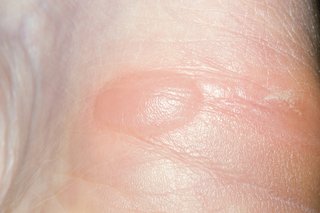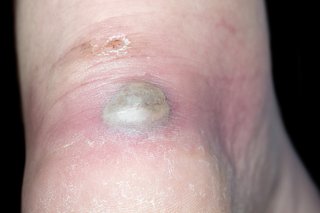Blisters should heal on their own within a week. They can be painful while they heal, but you shouldn't need to see a GP.
How you can treat a blister yourself
To relieve any pain, use an ice pack (or a bag of frozen vegetables wrapped in a towel) on the blister for up to 30 minutes.
To protect the blister and help prevent infection:
Do
- cover blisters that are likely to burst with a soft plaster or dressing
- wash your hands before touching a burst blister
- allow the fluid in a burst blister to drain before covering it with a plaster or dressing
Don't
- do not burst a blister yourself
- do not peel the skin off a burst blister
- do not pick at the edges of the remaining skin
- do not wear the shoes or use the equipment that caused your blister until it heals
A pharmacist can help with blisters
To protect your blister from becoming infected, a pharmacist can recommend a plaster or dressing to cover it while it heals.
A hydrocolloid dressing can help reduce pain and speed up healing.
Check if you have a blister

DR P. MARAZZI/SCIENCE PHOTO LIBRARY

DR P. MARAZZI/SCIENCE PHOTO LIBRARY

DR P. MARAZZI/SCIENCE PHOTO LIBRARY
Important
Don't ignore an infected blister. Without treatment it could lead to a skin or blood infection.
Non-urgent advice: See a GP if:
- a blister is very painful or keeps coming back
- the skin looks infected – it's red, hot and the blister is filled with green or yellow pus
- a blister is in an unusual place – such as your eyelids, mouth or genitals
- several blisters have appeared for no reason
- a blister was caused by a burn or scald, sunburn, or an allergic reaction
Treatment from a GP
Your GP might burst a large or painful blister using a sterilised needle. If your blister is infected, they may prescribe antibiotics.
They can also offer treatment and advice if blisters are caused by a medical condition.
How to prevent blisters
Blisters develop to protect damaged skin and help it heal. They are mostly caused by friction, burns and skin reactions, such as an allergic reaction.
Blood blisters appear when blood vessels in the skin have also been damaged. They are often more painful than a regular blister.
If you regularly get friction blisters:
- wear comfortable, well-fitting shoes
- gradually break in new shoes
- wear thicker wool socks during exercise
- dust talcum powder in your socks if you get sweaty feet
- wear protective gloves when you exercise or if you use tools at work
Conditions that can cause blisters
Page last reviewed: 12 December 2017
Next review due: 12 December 2020
